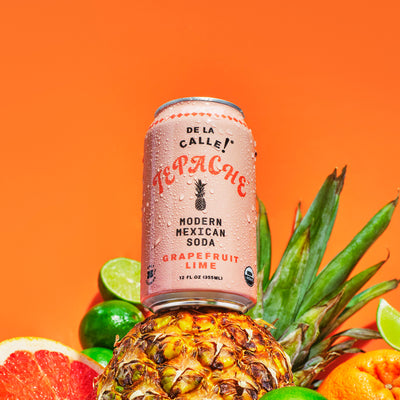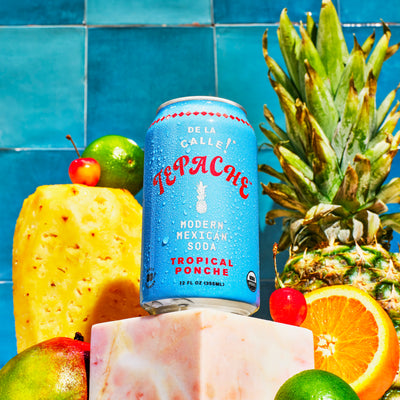Prickly Pear Cactus: What Is It & How Does It Taste?

The prickly pear cactus: beyond its charming name and cartoonish looks, what really is this succulent? What is the prickly pear cactus, and how does it taste?
“Prickly pear cactus” is not the cacti’s scientific name. It was given this name in reference to the fruit that it grows.
The cactus has many uses. It can be used in a variety of different flavorings or as a main dish in Mexican cuisine. From fried nopales to prickly pear margaritas, this plant is well-loved, and for good reason—it provides a truly unique flavor to your dishes.
However, “prickly” doesn’t exactly sound appetizing when we’re considering a snack. Why then has this cactus snuck its way into our hearts?
The prickly pear cactus has been around since ancient times. It was even used in ancient medicines as both a salve and an herbal medicine. This delectable and dynamic plant has a fascinating past and an exciting future. Its many uses have excited chefs and mixologists from around the world.
In this article, we cover where this plant grows, its uses (both ancient and current), and how it is harvested. We’ll also explore how the prickly pear fruit tastes and how it has evolved into a staple of modern cuisine.
Like rice and beans, tequila, and tepache, the prickly pear cactus earns itself an essential place in Mexican cooking. If you’re interested in learning more about fruity Mexican classics, you can read about other fruit commonly used in Mexican cooking here.
Let’s get into all there is to know about the prickly pear cactus.
What Is the Prickly Pear Cactus?
The prickly pear cactus is a specific species of cactus and a member of the Opuntia genus. It has many common names and subtypes, including "Engelmann's Prickly Pear" or Opuntia engelmannii, "Eastern prickly pear cactus" or Opuntia humifusa, "Beavertail Cactus" or Opuntia basilaris, and "Plains Prickly Pear" or Opuntia macrorhiza.
This genus of cacti is characterized in a few notable ways. First, the Opuntia cacti have flat “paddles” called cladodes with small prickles called glochids. These are seen as the “arms” of the cactus. Some have large spines, while others are spineless.
These paddles, also called nopales or nopalito, are used in dishes as a vegetable. Once shucked of its thorns, nopales can be enjoyed grilled, fried, or even raw. The species you'll see most frequently in cooking is the "Indian Fig" or Opuntia ficus-indica. Prickly pear includes nutrients like vitamin C, calcium, proteins, and fiber.
The prickly pear cactus has a decent range in size and height. Some of the fruit-bearing prickly pear cacti are akin to the size of a shrub. These fruits are called tuna.
Other prickly pear cacti of the Opuntia family can grow up to six meters tall. The major differentiating factor of the prickly pear cacti from other cacti in the Opuntia genus is its flowering fruits.
Where Does the Prickly Pear Grow?
The prickly pear cactus is native to the Western hemisphere. It grows best in tropical and subtropical climates from late July until September, although it may bloom as early as June.
The prickly pear cactus also grows well in the Southwestern United States in zones like Texas, the Mojave Desert, and New Mexico. It is very easily propagated from stem segments.
The prickly pear cactus is used for food and medicine, as well as in ornamental decor. The cacti have large flowers sprout from them before they produce their fruits.
Funny enough, the prickly pear cactus pads and fruits have different acidity levels throughout the day! For this reason, they are usually harvested mid-morning—this is when the acid contents of the paddles and fruits are at their lowest.
These plants are incredibly drought tolerant. They do not require much water at all. In fact, newly propagated paddles do not require any water for the first month of their propagation. They are basically a plant killer's dream.
Overall, the prickly pear cactus does not have a laundry list of care and keeping practices. They ask for high temperatures and water every two to four weeks.
Now we can get into its many uses and what we’re all wondering: how it tastes!
How To Enjoy the Prickly Pear
The prickly pear cactus has many uses outside of its flowering fruit. Prickly pear is used in dye production. Meanwhile, the paddles of the cactus, or nopales, are enjoyed as a side or main dish in Mexican cuisine.
However, the brightly colored prickly pear fruit is the star of this show. The first step in enjoying this fruit is harvesting it at the right time.
Unlike other fruits, like avocados, the prickly pear will not continue to ripen after being harvested. So it should be plucked from the cactus at its ripest.
To eat the fruit, you must remove the skin and all of its prickles. You can do this in two different ways.
The skin can be burned or cooked off, or it can be peeled off raw. Cooking the fruit makes it slightly easier to slip the skin off. When dealing with prickles, it’s best to choose the easiest method unless you are seeking a challenge.
Don't forget to use tongs when holding the pad, and wear thick gloves if you think you might encounter a prickle.
What Does the Prickly Pear Taste Like?
The taste of the prickly pear fruit depends greatly on how the fruit is prepared after harvesting. It can be jellied, candied, roasted, or eaten raw!
In its raw state, the prickly pear has a similar flavor to a subtly sweet melon. Many people also compare the prickly pear flavors to naturally sweetened bubble gum.
Many also suggest that the fruit tastes like a variation of watermelon. It is a subtly sweet taste, not an overwhelmingly saccharine one.
The fruit can come off slightly bland, similar to dragon fruit that grows on cacti. The fruit’s bright pink coloring implies a vibrancy of taste, but this is not always the case.
Uncooked, unsweetened, and un-jellied, the prickly pear fruit has a very gentle taste. For this reason, it pairs nicely with many stronger flavors.
Popular Uses of the Prickly Pear Cactus
Popular uses for the prickly pear flavor and essence are candy, gum, jams, and jellies.
The experiments do not stop there. Prickly pear can also be used to flavor salad dressings, sweet and savory sauces, bread, sweet cakes, ice creams, juices, and alcoholic drinks.
There you have it. The prickly pear is a funky and refreshing fusion of watermelon and bubblegum… basically.
This desert fruit has a multitude of uses. The prickly pear cactus itself is incredibly versatile, and this precious pink fruit just scratches the surface.
Prickly pear fruits are bright bursts in sparse deserts. They promise more than a refreshment or a sweet repose from endless flatlands. Prickly pear cacti promise a plethora of delicious desserts and fruity beverage delights.
A Prickly Prince
Hopefully, some of the mystery surrounding the prickly pear has been dispelled. With knowledge of the fruit’s flavor profile and a few new ways to enjoy it, there is no need to wonder about just what the prickly pear cactus is anymore.
Now is the time to go and get one and taste the subtly sweet delight for yourself! Kick back with a can of tepache and enjoy a piece of toast with prickly pear jelly on it.
Share a prickly pear lollipop with a loved one, or get to mixing some prickly pear margaritas for your next happy hour.
Sources:
Eating Cactus: Prickly Pear for Food- Extension | University of Nevada, Reno











